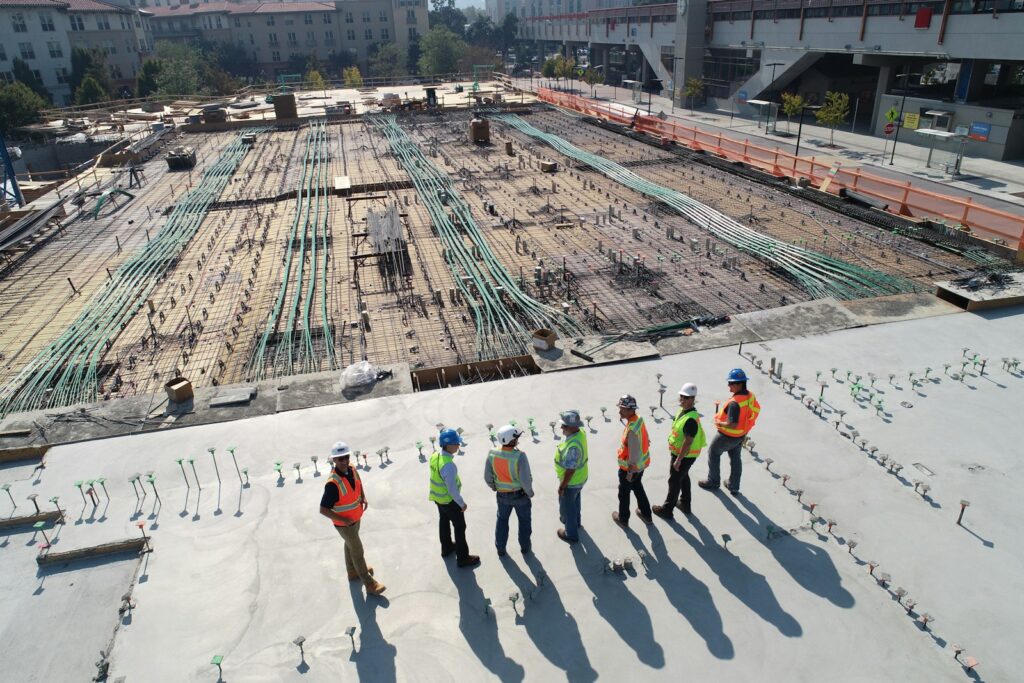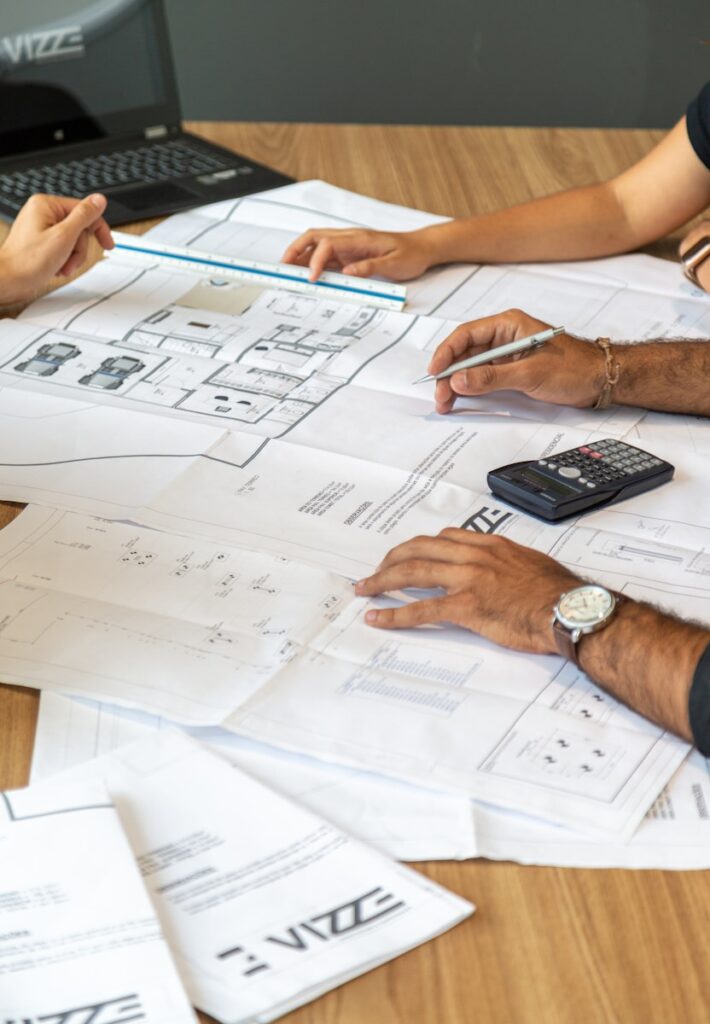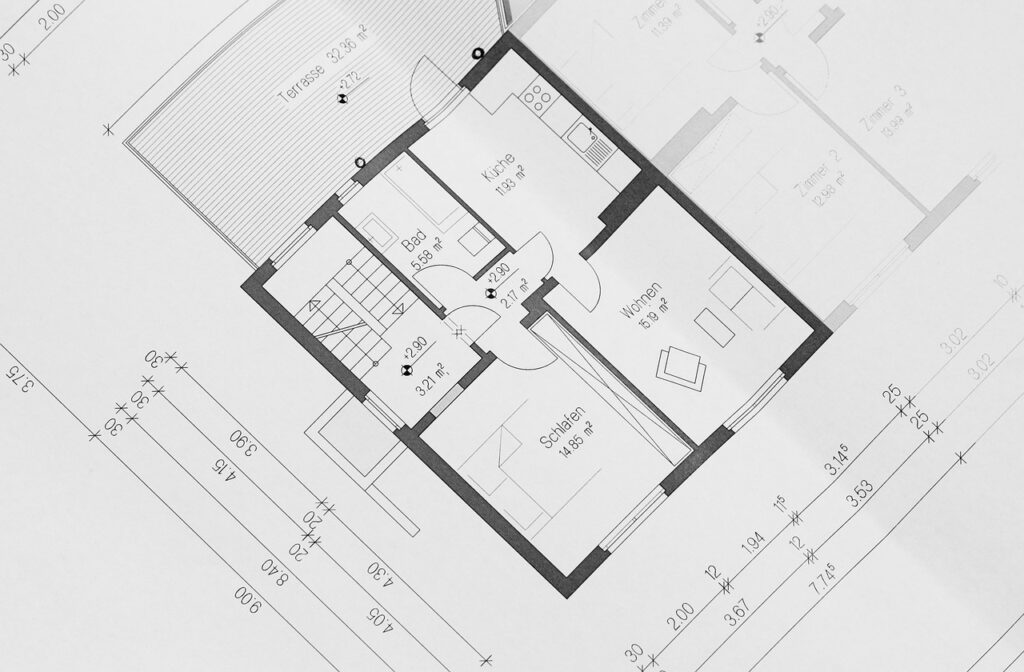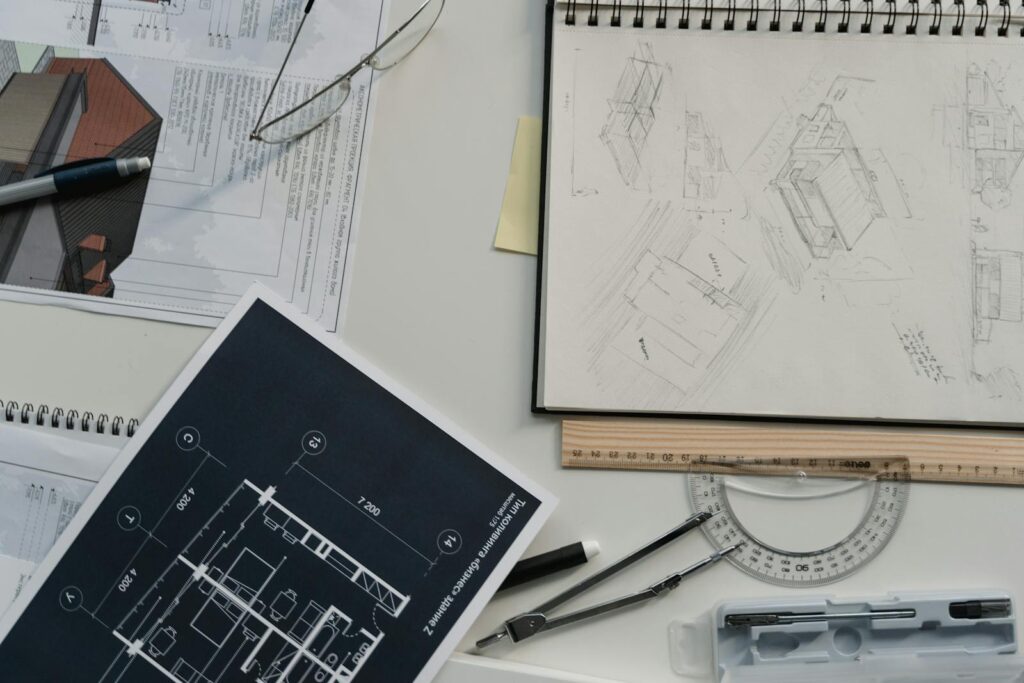If you’re preparing to kick off a new construction project, knowing how to read construction plans is your golden ticket. Construction project plans are the backbone of any building project, providing essential details, from site plans to mechanical systems.
But what exactly do these documents entail, and why are they so crucial? This guide is here to demystify construction plans and arm you with the knowledge needed to ensure your project runs smoothly. Let’s dig into the ins and outs of construction plans and their processes, offering tips and insights along the way.

Understanding Construction Plans
What Are Construction Plans?
Construction plans are comprehensive documents that detail every step and requirement of a construction project. They include essential elements such as building orientation and work tasks involved in planning a construction project at the construction site.
They serve as the blueprint for the entire project, outlining the project scope, objectives, deliverables, and necessary resources. These plans are vital for ensuring all parties involved have a clear understanding of the project, leading to better decision-making and reduced risks.
The construction plan acts as a roadmap for the project, guiding the construction team through various phases. It ensures everyone is on the same page, minimizing confusion and miscommunication. By detailing materials, labor requirements, schedules, and budgets, construction plans help in identifying opportunities and potential pitfalls before they arise.
Importance of Construction Plans
Construction plans are indispensable for a successful project. They help project managers and teams to keep the project on track, maintaining quality standards and adhering to timelines.
By clearly defining roles and responsibilities, these plans foster collaboration among stakeholders, including the project manager, construction team, and local building department.
Construction project plans are essential for managing the complexity and broad scope of construction projects. They involve defining work tasks and utilizing software for effective planning and scheduling, which facilitates detailed task breakdowns and hierarchies, aiding in project management and progress tracking.
Without a robust construction plan, projects can easily spiral out of control, leading to cost overruns, missed deadlines, and compromised quality. By clearly laying out the project’s framework, construction plans help in navigating challenges efficiently and adapting to changes as needed.
The Role of Construction Plans
The primary role of a construction plan is to provide a clear, organized approach to achieving the project’s goals. It outlines the specific tasks and timelines, helping teams focus their efforts and resources strategically.
By detailing the project scope and objectives, construction plans set the stage for a cohesive effort that aligns with the client’s vision and expectations.
Additionally, understanding the construction site is crucial. Proper orientation for energy efficiency and defining work tasks at the construction site are essential elements that ensure the project is completed efficiently.
Another key role of construction plans is to ensure compliance with local building codes and regulations. By detailing site plans and ensuring all necessary permits are secured, construction plans help avoid legal and regulatory setbacks that can stall progress.

Navigating the Construction Planning Process
Defining the Project
The first step in the construction planning process is defining the project. This involves outlining the project’s scope, objectives, and deliverables. It’s essential to identify all stakeholders, including the project manager, construction team, and local building department, to ensure everyone involved is aligned with the project goals.
Developing a detailed site plan is crucial at this stage, as it sets the foundation for the entire project. Properly assessing the construction site and its parameters, such as building orientation and work tasks, is essential for energy efficiency and project efficiency.
Ensuring compliance with local building codes and regulations is a critical aspect of this phase, helping to avoid costly delays and legal issues down the line.
Determining Business Benefits
Understanding the project’s business benefits is essential for justifying the investment. This involves calculating the return on investment (ROI) and identifying cost savings, increased revenue, and improved efficiency.
A well-developed business case that includes a cost-benefit analysis helps stakeholders see the project’s potential value.
By clearly articulating the business benefits, you can garner support from clients and stakeholders, ensuring they are committed to the project’s success. This step is vital for securing necessary approvals and funding.
Estimating Project Activities
Accurate estimation of project activities is crucial for successful construction planning. This involves developing a work breakdown structure (WBS) to identify tasks and their dependencies. Estimating the duration and resources required for each activity helps in creating a realistic schedule and budget.
Construction project plans are essential as they emphasize the importance of detailed task breakdowns and hierarchies, which facilitate project management and progress tracking.
Identifying potential risks and opportunities is also essential during this phase. Developing a risk management plan allows the team to proactively address challenges and seize opportunities, ensuring the project stays on track.
Create a Schedule
Creating a schedule is a crucial step in the construction planning process. A well-structured schedule outlines the timeline for the entire project, detailing the start and end dates for each task, the dependencies between tasks, and the resources required. This meticulous planning ensures that the construction project is completed on time, within budget, and to the required quality standards.
To create an effective schedule, start by identifying all the tasks involved in the project. Estimate the time required for each task and determine the dependencies between them. Tools like Gantt charts or project management software can be invaluable in this process.
A Gantt chart, for instance, is a type of bar chart that visually represents the project timeline, showing tasks on the vertical axis and time on the horizontal axis. This visualization helps in identifying potential bottlenecks and ensuring a smooth workflow.
A comprehensive schedule should include the following elements:
-
Task list: A detailed list of all tasks involved in the project.
-
Task duration: An estimate of the time required for each task.
-
Dependencies: The relationships between tasks, indicating which tasks must be completed before others can start.
-
Resources: The resources required for each task, including labor, materials, and equipment.
-
Milestones: Key events or deadlines in the project timeline.
By creating a detailed schedule, you can ensure that your construction project is well-planned, well-executed, and completed on time. This structured approach to scheduling is a cornerstone of effective construction planning and project management.
Defining Resource Requirements
Resource planning is a critical component of the planning phase. It involves identifying the labor, materials, and equipment needed for the project. Developing a comprehensive resource allocation plan ensures that resources are available and used efficiently throughout the project.
By carefully planning resource requirements, you can avoid unnecessary delays and cost overruns. Ensuring resources are allocated effectively helps maintain project momentum and supports timely completion.

Key Construction Planning Documents
Project Plan
The project plan is the overarching document that guides the construction project. It includes the objectives, scope, deliverables, schedule, and budget. The project plan serves as the foundation for decision-making throughout the project.
Construction project plans emphasize the complexity and broad scope of managing construction projects, which involves balancing various stakeholders, resources, and tasks.
Having a well-developed project plan ensures that all stakeholders are aligned and informed, reducing the risk of misunderstandings and miscommunication. Regularly reviewing and updating the project plan is essential for adapting to changes and maintaining relevance.
Project Charter and Business Case
The project charter is a formal document that authorizes the project and outlines its objectives, scope, and stakeholders. It serves as a reference point for the project team and helps ensure alignment with the client’s vision.
The business case provides a detailed justification for the project’s investment, highlighting the expected benefits and return on investment. It helps stakeholders understand the value of the project and fosters support and commitment.
Scope Statement and Work Breakdown Structure
The scope statement is a critical document that defines the project’s boundaries, objectives, and deliverables. It helps ensure a shared understanding of the project and sets clear expectations for all involved parties.
The work breakdown structure (WBS) is a hierarchical representation of the project’s activities, breaking them down into manageable tasks. It provides a framework for organizing and scheduling work, ensuring efficient resource allocation and task management.

Construction Project Management
Construction project management is the process of planning, organizing, and controlling a construction project from start to finish. It involves managing the project scope, schedule, budget, and resources to ensure successful completion.
Effective construction project management is essential for delivering projects that meet client expectations and adhere to quality standards.
Key activities in construction project management include:
-
Project planning: Defining the project scope, goals, and objectives.
-
Scheduling: Creating a detailed project schedule and timeline.
-
Budgeting: Establishing a project budget and implementing cost control measures.
-
Resource allocation: Assigning resources, including labor, materials, and equipment, to each task.
-
Risk management: Identifying and mitigating potential risks and threats to the project.
-
Quality control: Ensuring that the project meets the required quality standards.
-
Communication: Coordinating and communicating with stakeholders, including the project team, clients, and contractors.
Effective construction project management requires strong leadership, communication, and problem-solving skills. It also demands a deep understanding of the construction process, including the technical, financial, and regulatory aspects of the project.
By mastering these skills and activities, you can ensure that your construction projects are well-managed and successful.
Roles and Responsibilities
In a construction project, clearly defining and assigning roles and responsibilities is essential for ensuring smooth execution and successful completion. Key roles and their responsibilities include:
-
Project manager: The project manager oversees the entire project, including planning, scheduling, budgeting, and resource allocation. They are responsible for ensuring that the project stays on track and meets its objectives.
-
Construction team: This team includes contractors, subcontractors, and laborers who carry out the physical construction work. Their responsibilities include adhering to the project plan and maintaining quality standards.
-
Project engineer: The project engineer ensures that the project meets the required technical and quality standards. They oversee engineering aspects and provide technical support to the construction team.
-
Quality control manager: This role involves ensuring that the project meets the required quality standards. The quality control manager conducts inspections and tests to verify compliance with specifications.
-
Safety manager: The safety manager is responsible for ensuring that the project is executed safely and in compliance with all relevant safety regulations. They develop and implement safety plans and conduct regular safety audits.
By defining and assigning these roles and responsibilities, you can ensure that your construction project is well-organized, well-executed, and completed successfully. Clear role definition fosters accountability and efficiency within the construction team.

Tips for Effective Construction Planning
Develop a Comprehensive Project Plan
A comprehensive project plan is foundational for successful construction planning. It should include a detailed scope statement, schedule, and budget. The project plan serves as the roadmap for the project, guiding decision-making and ensuring alignment with objectives.
Construction project plans are crucial for managing the complexity and broad scope of construction projects. Defining work tasks and utilizing software for effective planning and scheduling can facilitate project management and progress tracking.
Regularly reviewing and updating the project plan is essential for adapting to changes and maintaining relevance. This process helps keep the project on track and ensures timely completion.
Identify Risks and Opportunities
Identifying potential risks and opportunities is crucial for effective construction planning. Developing a risk management plan allows the team to proactively address challenges and seize opportunities, ensuring the project stays on track.
By anticipating potential issues and planning for contingencies, you can minimize disruptions and maintain project momentum. This proactive approach fosters a culture of resilience and adaptability.
Engage Stakeholders Throughout the Project
Engaging stakeholders throughout the project is essential for ensuring alignment and commitment. Regular communication and collaboration help keep all parties informed and involved, fostering a sense of ownership and accountability.
By actively involving stakeholders, you can address concerns and make informed decisions that support the project’s success. Building strong relationships with stakeholders promotes trust and collaboration.

Maintaining Your Construction Project Plan
Regularly Review and Update the Plan
Regularly reviewing and updating the project plan is essential for maintaining relevance and effectiveness. Monitoring progress and performance allows you to identify areas for improvement and make necessary adjustments.
By staying proactive and adaptable, you can ensure the project remains aligned with its objectives and meets quality standards. This ongoing process fosters a culture of continuous improvement and success.
Monitor Progress and Performance
Monitoring progress and performance is crucial for maintaining project momentum. Regularly assessing the project’s status helps identify areas for improvement and ensures alignment with objectives.
By tracking progress against the project plan, you can make informed decisions and take corrective actions as needed. This approach supports timely completion and successful project outcomes.
Use Construction Planning Software
Using construction planning software can streamline the planning process and improve efficiency. These tools offer features such as scheduling, resource allocation, and progress tracking, helping teams collaborate and stay organized.
Construction project plans are essential for managing the complexity and broad scope of construction projects. Utilizing software for effective planning and scheduling ensures that detailed task breakdowns and hierarchies facilitate project management and progress tracking.
By leveraging technology, you can enhance communication, coordination, and decision-making throughout the project. This approach supports efficient project management and successful outcomes.

Submitting a Building Permit for Your Construction Project
Before starting a construction project, obtaining a building permit from your local building department is a critical step.
A building permit is a document that authorizes you to begin construction, ensuring that your project complies with local building codes and regulations.
To submit a building permit application, you will need to provide the following information:
-
Project plans: Detailed plans that show the design and layout of the project.
-
Project specifications: A document outlining the materials, equipment, and labor required for the project.
-
Site plan: A plan showing the location of the project on the site.
-
Building codes: Documentation that outlines the building codes and regulations applicable to the project.
Additionally, you will need to pay a fee for the building permit, which varies depending on the location and type of project.
Once the application is submitted, the local building department will review the plans and specifications to ensure compliance with the required building codes and regulations. If the plans and specifications are approved, the building department will issue a building permit, authorizing you to begin construction.
By submitting a building permit, you ensure that your construction project is executed safely and in compliance with all relevant building codes and regulations. This step is crucial for avoiding legal issues and ensuring the smooth progress of your construction project.

Conclusion
Construction plans are the backbone of any successful construction project. By providing a clear roadmap for the project, they guide teams through the various phases and ensure alignment with objectives.
By following best practices, such as developing a comprehensive project plan, identifying risks and opportunities, and engaging stakeholders, you can set your project up for success.
Stay proactive, adaptable, and committed to continuous improvement, and you’ll be well-equipped to tackle any construction challenge. For more insights and resources on effective construction planning, explore our recommended tools and techniques, and start mastering the art of construction management today.
Resources for Effective Construction Planning
To enhance your construction planning and management skills, consider exploring the following resources, tools, and communities:
-
Construction Management Association of America (CMAA): Visit CMAA for educational materials, workshops, and conferences that focus on construction management.
-
Procore Learning Portal: Procore’s Learning Portal offers online courses and tutorials on construction management software and industry practices.
-
Lean Construction Institute (LCI): LCI provides resources and training related to lean methodologies in construction, helping you improve efficiency and reduce waste.
-
National Institute of Building Sciences (NIBS): NIBS offers a wide range of publications, reports, and tools aimed at improving the built environment and construction practices.
-
Construction Industry Institute (CII): CII provides research, guidelines, and methodologies designed to improve the cost-effectiveness of capital projects.
-
Build It Green: Build It Green focuses on sustainable building practices and offers training, resources, and tools to help professionals incorporate eco-friendly methods into their projects.
-
RICS (Royal Institution of Chartered Surveyors): RICS offers extensive professional development options and resources specific to surveying and construction management standards internationally.
These resources can equip you with the knowledge and tools necessary to improve your construction planning processes and achieve successful project outcomes.

